An ACR Poker Charity Tournament Will Support the Breast Cancer Foundation
A guaranteed prize pool of $15,000 and a match of that same amount by ACR Poker raised funds for United Breast Cancer Foundation. Last year, nearly 300,000 new cases of breast cancer were diagnosed in the United States alone.

The ACR poker tournament helps the United Breast Cancer Foundation
Gambling for A Noble Cause
A tournament held online on Oct. 16 via the ACR Poker app helped raise funds for the United Breast Cancer Foundation this week. A guaranteed prize pool was worth $15,000, and ACR promised to match that figure.
Final totals of the amount that will go to the UBCF will depend on how many players participated in a multi-state poker tournament. ACR Poker also held similar charity events online for its customers in other countries where online card playing is legal.
The ACR Poker charity poker tournament was streamed live on Twitch. Tickets were available to viewers for $66, with spots in the $1 million ACR Poker’s Venom Warmup tournament at stake. That event renews daily during much of October until the 27th.
How the United Breast Cancer Foundation Helps
The organization raided in excess of $35 million in 2021, the most recent year that tax returns are available online. Donations help fund breast cancer screenings for those in need. Funds are also allocated for educational and awareness programs, as well as special grants for people living with breast cancer.
About Breast Cancer
Each year in the U.S., a third of all new cancer diagnoses are for breast cancer, according to BreastCancer.org. Breast cancer is the most common cancer among women in the U.S., excluding skin cancers. In 2024, an estimated 297,790 new cases of invasive breast cancer will be diagnosed in women, along with 55,720 cases of non-invasive (in situ) breast cancer, according to the American Cancer Society.
Breast cancer remains a leading cause of cancer-related death among women, with around 43,700 deaths expected this year. The lifetime risk for a woman in the U.S. is approximately 1 in 8 (13%). Despite these numbers, advances in screening and treatment have led to a decline in death rates since 1989. Age, family history, and lifestyle choices influence risk, while early detection and treatment significantly improve outcome statistics.



